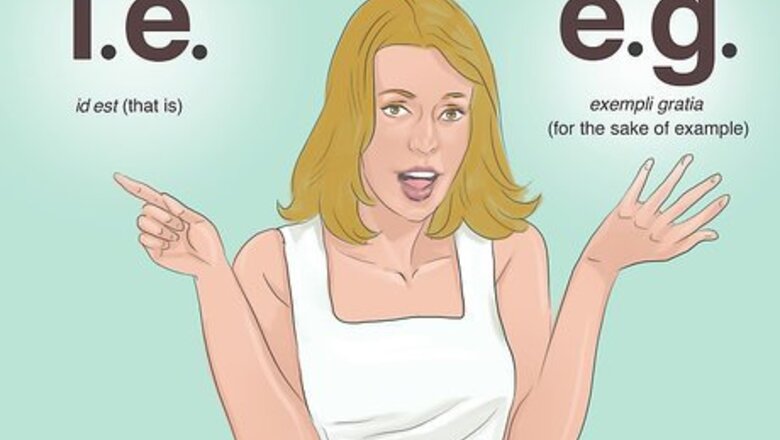
views
Distinguishing Between i.e. and e.g.
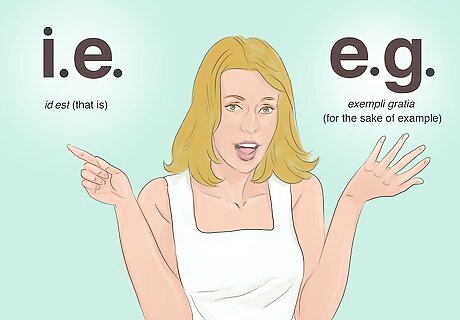
Understand what the abbreviations stand for. "i.e." is an abbreviation of the Latin words id est, which means "that is". "e.g." is an abbreviation for the Latin words exempli gratia, which means "for the sake of example".
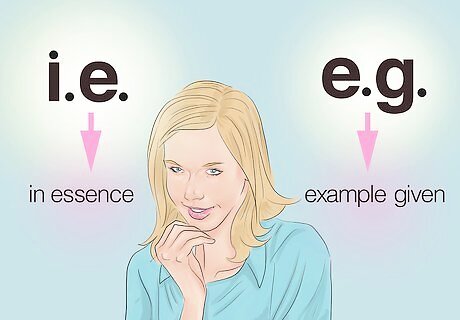
Associate each abbreviation with more easily remembered phrases. It may be difficult to memorize Latin words, so pretending that "i.e." stands for "in essence" or "in other words", and "e.g." stands for "example given" can help.

Use creative mnemonic devices. Sometimes, not even associating the abbreviation with another phrase helps. If you’re still having trouble, try using more creative mnemonic solutions, such as associating i.e. with “I explain” or e.g. with “egg sample” (which sounds like "example"). You could also try memorizing a bizarre example sentence using the correct abbreviation, such as “The best way to drive unicorns out of your neighborhood is to play them loud Baroque classical music (i.e., complicated classical music composed between 1600-1750).”
Knowing When to Use i.e. and e.g.
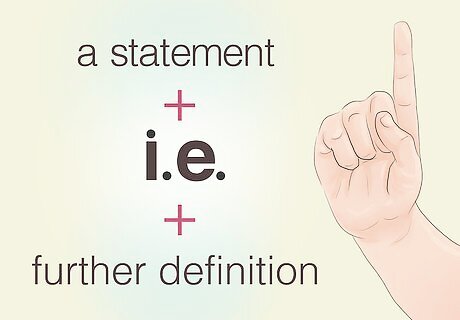
Use "i.e." to paraphrase. Make a statement, then add "i.e." to explain, specify, or describe what you just said in another way: The elephant is a pachyderm, i.e., a large animal with thick skin and nails on feet resembling hooves. I went to my least favorite place (i.e., the dentist). Note that what follows "i.e." is often a further explanation. This can also be a metaphor. If you substitute "i.e." with "in other words" the sentences still make sense. If you plug in "for example" they do not.
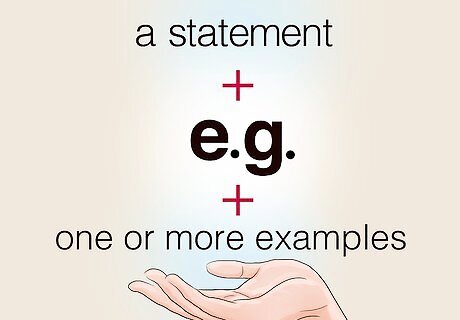
Use "e.g." before giving one or more examples. Think of what precedes "e.g." as a category, and what follows it as something (or a few things) that would fall into that category (but not everything in that category): Buy some vegetables, e.g., carrots. I like power metal (e.g., Firewind, Iced Earth, Sonata Arctica). Observe how using "i.e." wouldn't make sense in these examples. "Carrots" is not another way to describe vegetables in general, it is just one of the many foods that are considered to be vegetables. If you wanted to use "i.e." you would write "Buy some vegetables, i.e., the edible part of any plant." Likewise, the bands given are examples of power metal, but not a description. If you were using "i.e." you would write something like "I like power metal, i.e., fast metal with symphonic elements and epic themes."
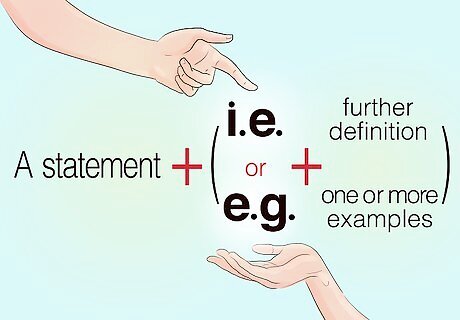
Use e.g. and i.e. in short comments. It’s common to use the abbreviations e.g. and i.e. when adding a parenthetical statement, such as a clarification or explanation. However, if the clarification or explanation is part of the main sentence, spell out the phrase that is appropriate to your meaning instead. For example, if you’re writing a paper and want to provide some examples of sources that argue a particular point, use e.g.: “Some studies (e.g., Smith, 2015; Yao, 1999) support this assertion, while others -- for example, Abdullah’s (2013) research on pizza and topping choice -- disagree.” Use i.e. to provide short clarifications and a phrase to provide longer or more detailed clarifications: “In our research we altered the order of image display (i.e., first, second, or third) as well as their color scheme, that is, whether we had applied a blue or green filter.”

Consider your audience. Substantial confusion exists surrounding i.e. and e.g., even amongst highly educated readers. If you think that your readers may not understand what the abbreviation is used to signal, skip it and use a clarifying phrase instead.
Formatting and Double-Checking Usage of i.e. and e.g.

Italicize only if specifically asked. It’s common for English speakers to see Latin words and phrases italicized, such as in medias res (“in the middle of things”) or in loco parentis (“in the place of a parent”). However, Latin words and phrases that have entered common usage are usually not italicized -- including i.e. and e.g.
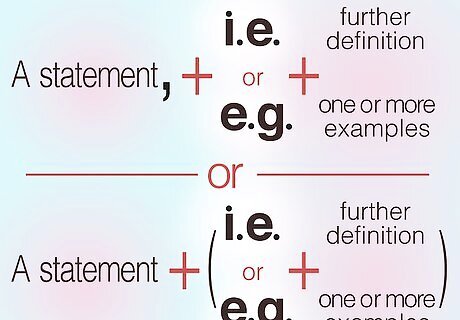
Use parentheses or commas with both. To indicate a separate clause, you can either insert a comma before "i.e." or "e.g." or you can use parentheses, both of which are shown in the examples above. If you use parentheses, open them right before the "e.g." or "i.e." and close them after you have given your example or alternate definition. For American English usage, you should always put a comma right after both "i.e." and "e.g." as shown in the examples above. For British English usage, do not put a comma right after either "i.e." or "e.g."

Determine any style manual requirements. If you’re just writing for yourself or in an informal situation, you may not have any specific requirements. However, if you’re writing in a particular academic discipline, or in a particular profession (such as journalism), you will probably be asked to write in accordance with the relevant style manual. For example, APA Style, the official style of the American Psychological Association, is used widely in the social sciences and in professions like journalism. APA states that you should always put a comma after e.g. and i.e. when using them: “Some sources (e.g., Janet, 2010; Jeff, 2015) argue that mushrooms are tasty” and “There are three meals in the day (i.e., breakfast, lunch, and dinner)”.
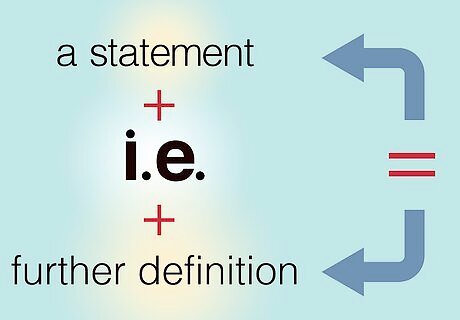
Ensure that what you write after i.e. means the same as what precedes it. If you use a sentence that includes i.e. and a parenthetical comment, make sure that the restatement is directly equivalent to what you said first: you should be able to swap them out without a loss of meaning. The sentence “His favorite type of sandwich is an open-faced sandwich (i.e., one that uses only one piece of bread rather than two)” represents correct usage of i.e. The sentence “His favorite type of sandwich is an open-faced sandwich (i.e., a panini or similar type of sandwich)” represents incorrect usage, because “a panini or similar type of sandwich” is NOT directly equivalent to “an open-faced sandwich.”
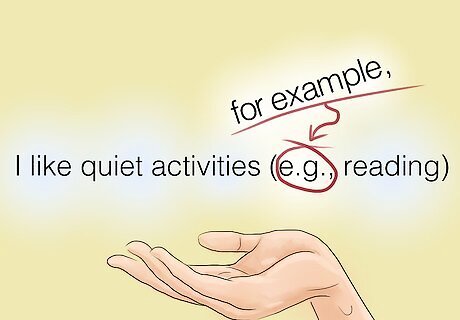
Try replacing the abbreviations with their meaning. If it sounds reasonable, then you are probably using the right one. For example, "I like quiet activities (e.g., reading)" becomes "I like quiet activities (for example, reading)". When trying this with i.e., it is often easier to use "in other words" instead of "that is."



















Comments
0 comment